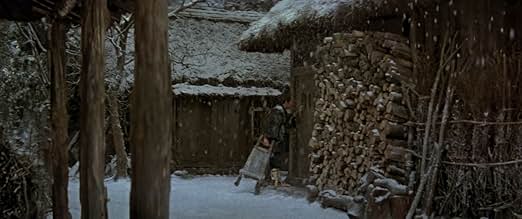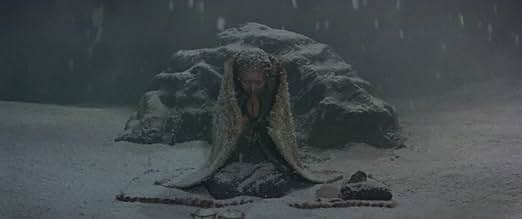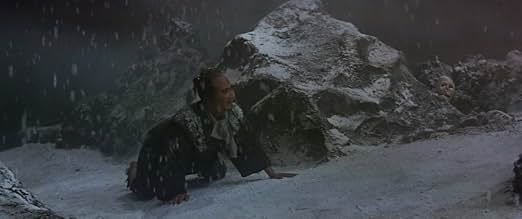NOTE IMDb
7,8/10
4 k
MA NOTE
Ajouter une intrigue dans votre langueA kabuki theatre-inflected story about a poor village whose people have to be carried to a nearby mountain to die once they get old.A kabuki theatre-inflected story about a poor village whose people have to be carried to a nearby mountain to die once they get old.A kabuki theatre-inflected story about a poor village whose people have to be carried to a nearby mountain to die once they get old.
- Réalisation
- Scénario
- Casting principal
- Récompenses
- 6 victoires et 1 nomination au total
Avis à la une
This is the story of an old woman who according to customary tradition of the remote Japanese village where she lives, must be carried by his son to the top of the neighbouring Narayama mountain to meet the gods and die since she has reached 70 years of age. Behind this tradition who seems awful to our western minds, lies the fact that the community is too poor to be able to support its old people. But tradition doesn't always subjugate human feelings and if the old woman shows herself as resigned to her fate and even displays some joy in fulfilling the tradition rules, his son feels a deep sorrow in accomplishing that terrible duty and while doing it he must fight in his heart and mind to subdue those loving and compassionate feelings. The scene at the top of the mountain when he is carrying his mother and ends up by laying her on the ground where soon snow begins to fall is intensely tragic in its silence interrupted now and then by the outbursts of the powerless and extremely emotional son's revolt. All along the film we hear to the voice off of a commentator who narrates the story accompanied by a beautiful traditional Japanese music. This commentator's performance reminds us of the role of the chorus present in ancient Greek tragedies. The images make us think of the traditional Japanese paintings with their patches of neat colours making a somewhat theatrical scenery. This movie gives way to deep emotions although not exposed with our kind of western reactions but with Japanese type ones which doesn't make them appear less human.
In Kabuki style, the film tells the story of a remote mountain village where the scarcity of food leads to a voluntary but socially-enforced policy in which relatives carry 70-year-old family members up Narayama mountain to die.
Roger Ebert of the Chicago Sun-Times rated the film a maximum 4 stars, and added it to his Great Movies list in 2013, making it the final film he added to the list before his death. In a June 1961 review in The New York Times, A.H. Weiler called the film "an odd and colorful evocation of Japan's past that is only occasionally striking"; "It is stylized and occasionally graphic fare in the manner of the Kabuki Theatre, which is realistically staged, but decidedly strange to Western tastes." I have to respectfully disagree with Weiler. Perhaps at the time the film was strange to Western taste. I couldn't speak to that. But I find it quite refreshing, and really enjoy how they made it obvious that the story was told on a stage. Rather than hide the stag as American films do, this one embraces it, so you know you are really watching a story and it need not be any more than that. And yet, it is not just theater but a bigger experience.
Roger Ebert of the Chicago Sun-Times rated the film a maximum 4 stars, and added it to his Great Movies list in 2013, making it the final film he added to the list before his death. In a June 1961 review in The New York Times, A.H. Weiler called the film "an odd and colorful evocation of Japan's past that is only occasionally striking"; "It is stylized and occasionally graphic fare in the manner of the Kabuki Theatre, which is realistically staged, but decidedly strange to Western tastes." I have to respectfully disagree with Weiler. Perhaps at the time the film was strange to Western taste. I couldn't speak to that. But I find it quite refreshing, and really enjoy how they made it obvious that the story was told on a stage. Rather than hide the stag as American films do, this one embraces it, so you know you are really watching a story and it need not be any more than that. And yet, it is not just theater but a bigger experience.
The Ballad Of Narayama (aka: Narayam bushiko) is a film by Keisuke Kinoshita, whose directing career stretched over 40 years. In notable fashion it mixes kabuki style balladeer narration and musical accompaniment with a tragic story set around responsibilities of old age, rural hardship, family cruelty and the painful obligations brought by restrictive and conservative social convention. It's a consideration of that which is a characteristic of many films made before, and during, the golden age of Japanese cinema. In the hands of masters like Mizoguchi, for instance, such depictions frequently evolved into profound considerations of the female condition. (In fact star Kinuyo Tanaka, was a favourite of that master, having previously appeared in films like Sansho Dayu and Ugetsu Monogatari.) Narayama is of that old school: an often painful - this viewer for one will long remember the moment when the old woman knocks out her own teeth on the edge of a stone grinder - and frequently moving account of a society which denies dignity to the old but which, at least in one instance, is granted them anyway. Such a traditional style of storytelling all but vanished when a new wave of Japanese directors come to prominence in the following decade. As others have observed the biggest irony of the film is that grandmother Orin is probably the single most productive member of her immediate circle. Of her nearest relatives, as she herself says: "Tatsuhei and Kesakichi are useless" - seen thus, her looming absence is very much a tragedy on both a social, as well as a personal, level.
Much of Narayama's power is drawn from its exquisite staging, an entirely successful recreation of a village environment and surrounding countryside done entirely in the studio. Except for the striking final shots, every part of the film is artificial, including the passing of time, even if emotions evoked thereby are not. Intense character interactions are sometimes emphasised in pools of light, while at another moment the set is lit in an ominous red; painted backcloths occasionally drop to provide transition between one scene and another, while actors end their parts in silhouette as the next action starts up behind them. Close ups are used sparingly, characters typically seen at a distance in their environment, again as on a stage. It is a process unique to this version of the tale, based on the folk story Dumping Grannies. It was one that, incidentally, was not copied over by Imamura in his, also critically successful, 1983 remake of Narayama with the result that that film arguably had a wider international appeal (it won top prize at Cannes).
In a different tradition entirely, the artificiality and expressionism on display in the present version recall that of Kwaidan (1964) a colour horror film where even the sun and sky are painted in dramatic fashion - even though not with quite the intensity. The result of Narayama's very deliberate technique is to emphasise the narrative texture of events as well at the same time to place them firmly within a particularly nationalistic tradition of story telling. It's also a cumulative effect given abrupt contrast by the last scene of the film, which places events back in a modern context.
In the film, moments of pathos and tragedy frequently counterbalance those of formality and ritual, and it's the tension between these two that gives the results power, and their Japanese flavour. This is most notable during the final trip to the mountain, one made by the despairing son carrying his grandmother upwards on his back. It's a long journey both for the principals as well as in actual screen time, as the passage occupies long and frequently silent minutes as they pass deliberately through the artificially crafted landscape. It's one that has been previously described, and its responsibilities circumscribed, by the precise instructions of village elders. But it speaks volumes too as far as the central relationship is concerned; heartbreaking as the mother refuses to communicate during her final hours, and as we see Tatsuhei torn between duty and natural familial feeling.
As one might expect the performances in Narayama are uniformly excellent, although that of Tanaka ought to be singled out for especial praise. Her portrayal of Orin conveys sadness, warmth and self-sacrifice in equal, convincing measure. With her entirely honourable acceptance of her destiny, and blind faith in the reasoning behind it, she is as much a reflection of her society as she is criticism of it. Termed by her contemporaries the "33 devil teeth woman" for her unhelpfully intact dental work (a sign of her continuing, unwelcome food consumption), Orin never the less retains a defining put-upon dignity which remains intact for the duration of the film, even when she says nothing but droops sadly, carried to her fate on her son's back.
A world away from the MTV editing techniques and CGI laden work of contemporary Hollywood product, some will find the essentially static nature of this film a challenge, and indeed for a introduction to classic Japanese cinema viewers would be better directed to the contemporary work of Kurosawa. Others will be pleased that such a relatively hard to see classic is at last available after some time out of circulation. The Ballad Of Narayama is a film whose formal beauty and human qualities impress even today.
Much of Narayama's power is drawn from its exquisite staging, an entirely successful recreation of a village environment and surrounding countryside done entirely in the studio. Except for the striking final shots, every part of the film is artificial, including the passing of time, even if emotions evoked thereby are not. Intense character interactions are sometimes emphasised in pools of light, while at another moment the set is lit in an ominous red; painted backcloths occasionally drop to provide transition between one scene and another, while actors end their parts in silhouette as the next action starts up behind them. Close ups are used sparingly, characters typically seen at a distance in their environment, again as on a stage. It is a process unique to this version of the tale, based on the folk story Dumping Grannies. It was one that, incidentally, was not copied over by Imamura in his, also critically successful, 1983 remake of Narayama with the result that that film arguably had a wider international appeal (it won top prize at Cannes).
In a different tradition entirely, the artificiality and expressionism on display in the present version recall that of Kwaidan (1964) a colour horror film where even the sun and sky are painted in dramatic fashion - even though not with quite the intensity. The result of Narayama's very deliberate technique is to emphasise the narrative texture of events as well at the same time to place them firmly within a particularly nationalistic tradition of story telling. It's also a cumulative effect given abrupt contrast by the last scene of the film, which places events back in a modern context.
In the film, moments of pathos and tragedy frequently counterbalance those of formality and ritual, and it's the tension between these two that gives the results power, and their Japanese flavour. This is most notable during the final trip to the mountain, one made by the despairing son carrying his grandmother upwards on his back. It's a long journey both for the principals as well as in actual screen time, as the passage occupies long and frequently silent minutes as they pass deliberately through the artificially crafted landscape. It's one that has been previously described, and its responsibilities circumscribed, by the precise instructions of village elders. But it speaks volumes too as far as the central relationship is concerned; heartbreaking as the mother refuses to communicate during her final hours, and as we see Tatsuhei torn between duty and natural familial feeling.
As one might expect the performances in Narayama are uniformly excellent, although that of Tanaka ought to be singled out for especial praise. Her portrayal of Orin conveys sadness, warmth and self-sacrifice in equal, convincing measure. With her entirely honourable acceptance of her destiny, and blind faith in the reasoning behind it, she is as much a reflection of her society as she is criticism of it. Termed by her contemporaries the "33 devil teeth woman" for her unhelpfully intact dental work (a sign of her continuing, unwelcome food consumption), Orin never the less retains a defining put-upon dignity which remains intact for the duration of the film, even when she says nothing but droops sadly, carried to her fate on her son's back.
A world away from the MTV editing techniques and CGI laden work of contemporary Hollywood product, some will find the essentially static nature of this film a challenge, and indeed for a introduction to classic Japanese cinema viewers would be better directed to the contemporary work of Kurosawa. Others will be pleased that such a relatively hard to see classic is at last available after some time out of circulation. The Ballad Of Narayama is a film whose formal beauty and human qualities impress even today.
It gets a little tedious to relate current events to old movies so apologies dear reader, but while watching this film I couldn't help but think of the heartless voices in American politics that suggested old people sacrifice themselves for the good of the economy during the pandemic this year. It also made me think of Make Way for Tomorrow (1937) and Midsommar (2019), and maybe that's all you need to know (and then some).
Bless the little old lady at its center (Kinuyo Tanaka) - she's so sweet, and certainly contributes to the family by catching fish, hauling the harvest, and cooking, which makes her treatment even more heartbreaking. Whether the practice of obasute is legendary or not, it's easy to see a real-world parallel to how older people are too often forgotten, shoved aside, or abused, which may touch some painful chords in the viewer.
Here we see cruelty that is at times blunt (her annoying-as-hell grandson), ritualized (perhaps to help rationalize it), and in some sense born out of brutal economic need (food is a luxury, and making white rice once a year is a special treat). It all reflects losing our humanity with how we treat the elderly. The film lags a little bit in its last half hour, but it absolutely brims with emotion. The kabuki styling of the storytelling from director Keisuke Kinoshita is delightful, and made me think of our painful little lives as on the stage, each in one role today, and another tomorrow.
Bless the little old lady at its center (Kinuyo Tanaka) - she's so sweet, and certainly contributes to the family by catching fish, hauling the harvest, and cooking, which makes her treatment even more heartbreaking. Whether the practice of obasute is legendary or not, it's easy to see a real-world parallel to how older people are too often forgotten, shoved aside, or abused, which may touch some painful chords in the viewer.
Here we see cruelty that is at times blunt (her annoying-as-hell grandson), ritualized (perhaps to help rationalize it), and in some sense born out of brutal economic need (food is a luxury, and making white rice once a year is a special treat). It all reflects losing our humanity with how we treat the elderly. The film lags a little bit in its last half hour, but it absolutely brims with emotion. The kabuki styling of the storytelling from director Keisuke Kinoshita is delightful, and made me think of our painful little lives as on the stage, each in one role today, and another tomorrow.
"The balad of Narayama" is about the so called "Ubasute". An elderly person is carried to a mountain and left there to die. According to recent insights "ubasute" is an ancient legend and was never a real practice.
Wit an aging population the relevance of this myth is rising also in the Western world, if only as warning againt tensions between the generations. In the Netherlands there were some ugly discussions about elderly people occupying scarce intensive care capacity at the beginning of the Covid pandemic.
The 1958 version of "The balad of Narayama" is less well known as the movie of the same name by Shohei Imamura from 1983. It differs in two respects.
In the first place there is a material difference. In this movie the center of gravity is on the different ways that people can handle and accept their own mortality. In the Imamura movie the accent is on the battle between the generations for the scarce food supplies (or scarce health care capacity in my example given anbove).
In the second place there is a stylistic difference. This movie is much more artificial, reminding of the traditional Japanese Kabuki drama. In its artificiality of the use of colors it also reminds of "Kwaidan" (1964, Masaki Kobayashi).
I like the version of Keisuke Kinoshita better then the later one of Shohei Imamura. The reason being, I think, that the stylistic artificiality is better suited for the mythical character of the story.
Wit an aging population the relevance of this myth is rising also in the Western world, if only as warning againt tensions between the generations. In the Netherlands there were some ugly discussions about elderly people occupying scarce intensive care capacity at the beginning of the Covid pandemic.
The 1958 version of "The balad of Narayama" is less well known as the movie of the same name by Shohei Imamura from 1983. It differs in two respects.
In the first place there is a material difference. In this movie the center of gravity is on the different ways that people can handle and accept their own mortality. In the Imamura movie the accent is on the battle between the generations for the scarce food supplies (or scarce health care capacity in my example given anbove).
In the second place there is a stylistic difference. This movie is much more artificial, reminding of the traditional Japanese Kabuki drama. In its artificiality of the use of colors it also reminds of "Kwaidan" (1964, Masaki Kobayashi).
I like the version of Keisuke Kinoshita better then the later one of Shohei Imamura. The reason being, I think, that the stylistic artificiality is better suited for the mythical character of the story.
Le saviez-vous
- AnecdotesThis was the final film to be added to Roger Ebert's list of "Great Movies" before his death on April 4, 2013 at the age of 70.
- ConnexionsFeatured in Tvennesnack: Varför kan vi inte komma ihåg den här jävla filmen? (2022)
Meilleurs choix
Connectez-vous pour évaluer et suivre la liste de favoris afin de recevoir des recommandations personnalisées
- How long is The Ballad of Narayama?Alimenté par Alexa
Détails
- Date de sortie
- Pays d’origine
- Langue
- Aussi connu sous le nom de
- The Ballad of Narayama
- Lieux de tournage
- Société de production
- Voir plus de crédits d'entreprise sur IMDbPro
Contribuer à cette page
Suggérer une modification ou ajouter du contenu manquant

Lacune principale
By what name was La ballade de Narayama (1958) officially released in Canada in English?
Répondre



























